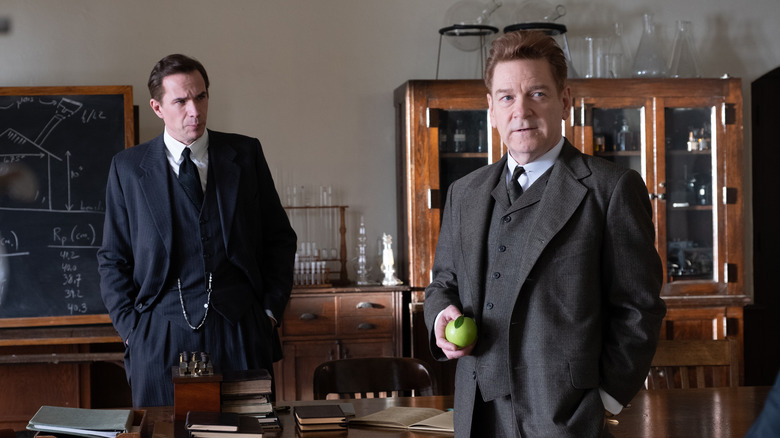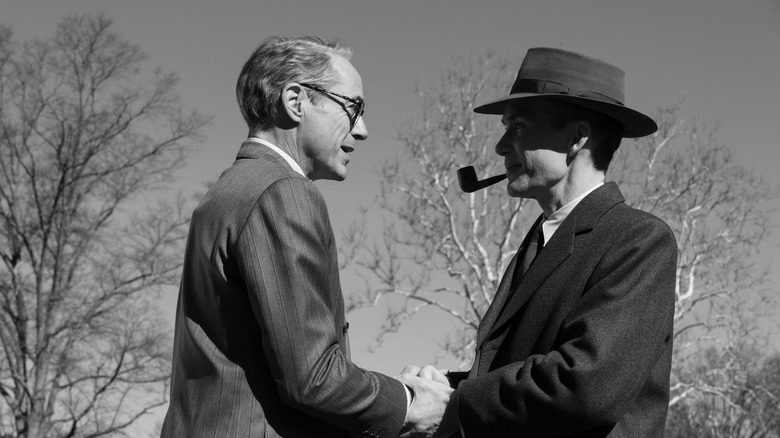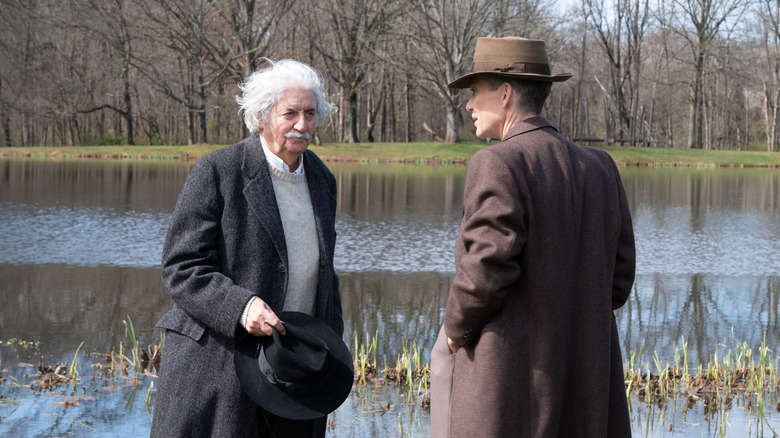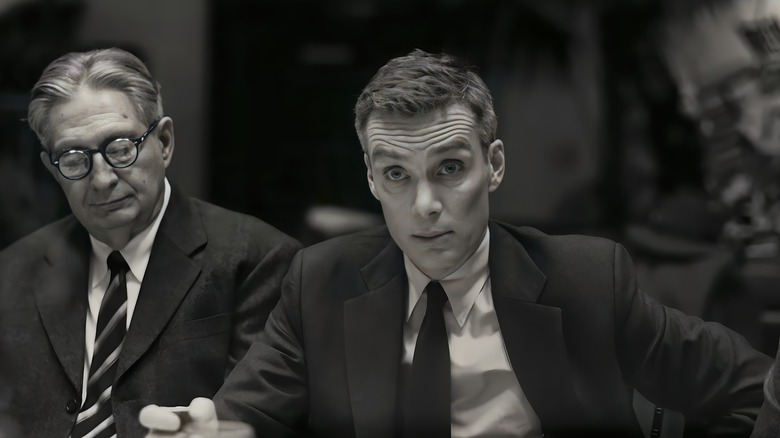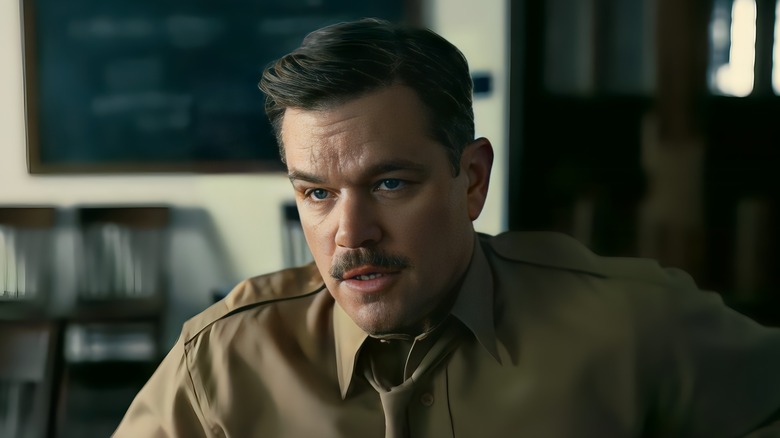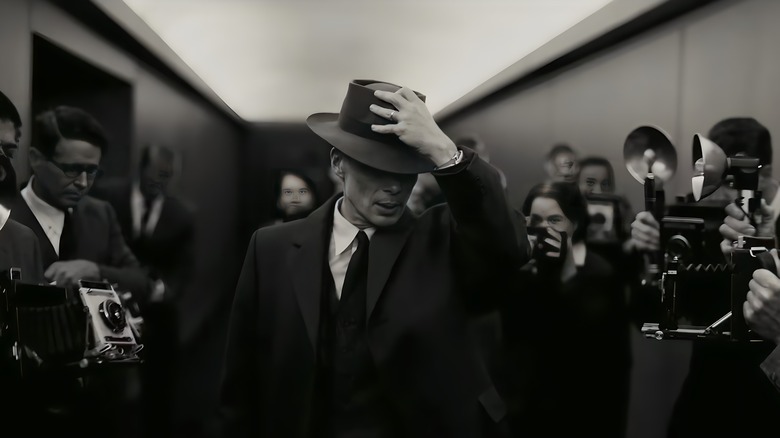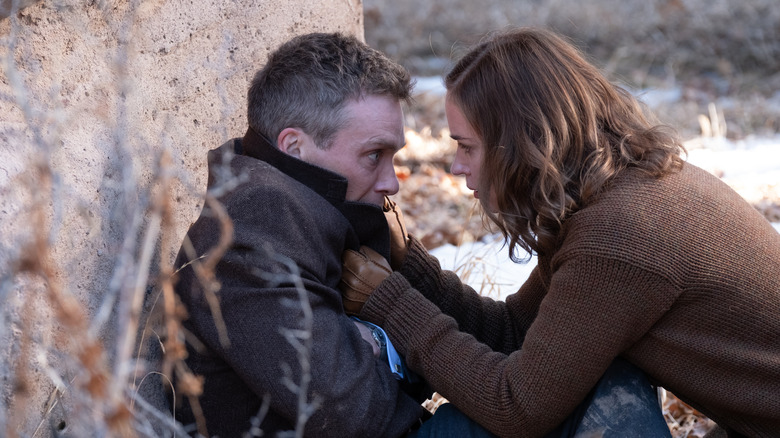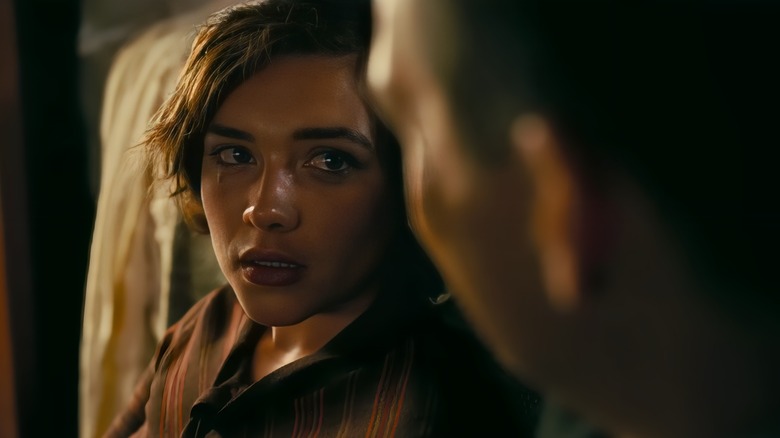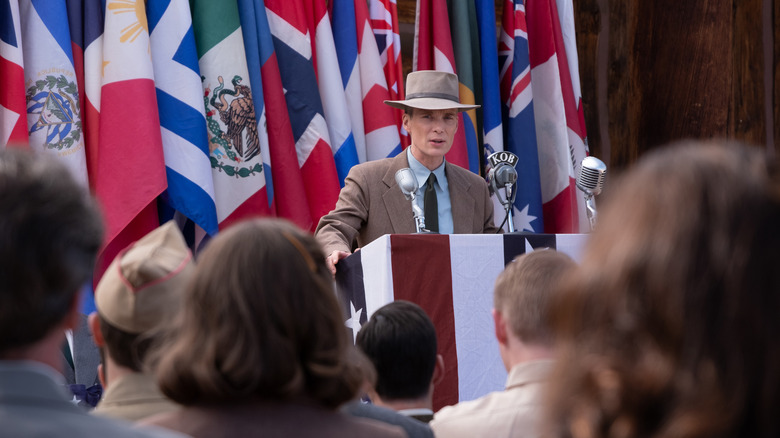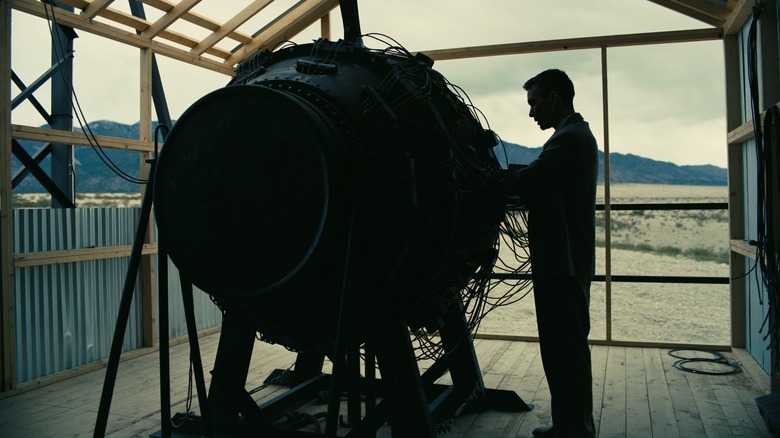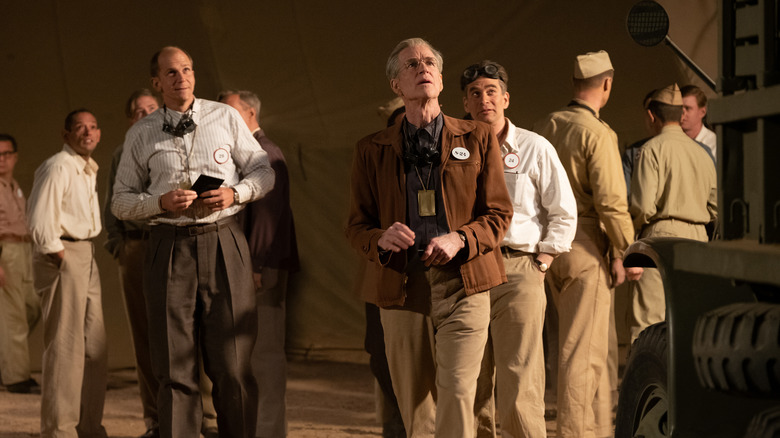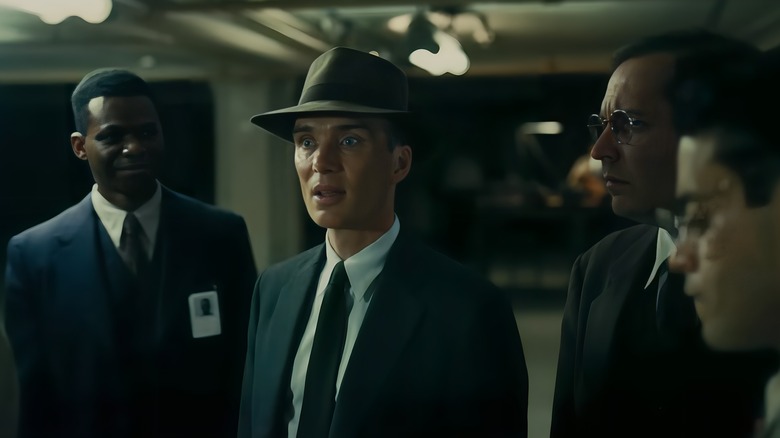Small Details You Missed In Oppenheimer
Christopher Nolan's "Oppenheimer" is so incredibly dense that even its gargantuan three-hour runtime feels like a whirlwind. There are dozens of important characters and decades' worth of storytelling, all presented in a rapid-fire, non-linear format that leaps from scene to scene. As such, the movie can be a bit hard to follow at times, and there are tons of small details that may get lost on your first time through.
For one, the film is a lot more historically accurate than you might suspect. Little details that seem at first like Hollywood flourishes are in fact pulled straight from Oppenheimer's life. And of course, because this is a Nolan film, there are plenty of little setups throughout the story that tie into lines or moments later on. Given the grim subject matter, it may be the writer-director's most thematically ambitious project yet.
"Oppenheimer" is meant to be overwhelming. It's designed to flood your senses, bombarding viewers with a nonstop avalanche of sound and inevitability. The big strokes are executed spectacularly, but it's the small details of Nolan's "Oppenheimer" that truly elevate it and make it one of his best films.
The poison apple story is based in truth
At the beginning of the movie, we follow a young J. Robert Oppenheimer (Cillian Murphy) during his studies in physics across Europe. While at Cambridge and severely depressed, he becomes frustrated with his highly critical instructor, future Nobel Prize winner Patrick Blackett (James D'Arcy). In an unthinkable fit of anger, Oppenheimer injects an apple on the professor's desk with deadly potassium cyanide. He quickly regrets the decision and races back to the classroom to dispose of the apple, only to find his idol, Niels Bohr (Kenneth Branagh), holding it. Thankfully, the whole affair ends quietly without anyone taking a bite.
Though dramatized, this bizarre event is based in real history. Oppenheimer's poor mental health at Cambridge is well documented, and according to various reports — including some from himself — he did indeed attempt to poison one of Blackett's apples. The severity of the actual encounter is debated, and it wasn't necessarily anything as dangerous as cyanide. The inclusion of Bohr is a fictional addition from Christopher Nolan, but the kernel of the story remains true.
In the film, this moment is played like dark foreshadowing. It demonstrates a fickleness and flippant disregard for life from Oppenheimer that could be extrapolated into his work on the Manhattan Project. These larger thematic implications are more for the sake of good storytelling, but it's intriguing to know just how troubled the young Oppenheimer was.
What the black and white scenes really mean
Like "Memento," Christopher Nolan's second film, "Oppenheimer" contains some scenes in color and others in black and white. If you're familiar with his past work, you might assume that the division is being used in the same way as the earlier movie — to differentiate between two different points in time. At first, that holds somewhat true, with the black and white scenes all taking place after the Manhattan Project.
However, the theory doesn't stay consistent. Oppenheimer's hearing is shot in color despite taking place well after World War II. By the end of the movie, we even get versions of the same scenes in both color and black and white. The real distinction seems to be that the black and white scenes show things from the perspective of Lewis Strauss (Robert Downey Jr.), the primary villain of the film in its final act. His congressional hearing and all of his meetings are shot in black and white, as are his versions of different encounters with Oppenheimer.
At the very start of the movie, there's another curious distinction drawn between the two modes. An early color scene features the title card, "1. Fission," and a black and white scene right afterward is captioned with "2. Fusion." This could simply signify that Oppenheimer's work was in fission bombs and Strauss advocated for the hydrogen bomb, which uses nuclear fusion. Or there could be a deeper significance meant to set the two characters apart.
The importance of water
Throughout "Oppenheimer," water plays a subtle but important role. The opening shot is of Oppenheimer standing in the rain, staring down at the puddles collecting and splashing on the ground at his feet. This shot is immediately interrupted by one of his apocalyptic visions, which shows billowing flames engulfing the world.
Contrasting these two opposites — the cooling, life-giving power of water and the infernal destruction of the thing Oppenheimer creates — sets the tone for the rest of the movie. As the story progresses, water remains a recurring antithesis. One of the only real moments of respite in the film is Oppenheimer's conversation with Albert Einstein (Tom Conti) by the pond at Princeton. It's a core scene, repeatedly returned to over the course of the movie and ultimately serving as the final note. Standing over the pond and staring into it, the two scientists discuss the many evils wrought by their discoveries. It's as if the pond is their way of trying to find some kind of peace.
Even the Trinity test itself is nearly prevented by a sudden rainstorm, although as Oppenheimer predicts, the storm breaks in time. He knows the way the rain works in New Mexico, a place he deeply loves. However, that natural landscape is forever changed by the detonation of the bomb that he builds.
Oppenheimer's black hole research is a giant metaphor
Early in the film, before he's recruited to lead the Manhattan Project, Oppenheimer's primary area of study is black holes (yet to be named that) and neutron stars. At the party where he first meets Jean Tatlock (Florence Pugh), he's knee-deep in black hole research, clearly fascinated by the inherent paradoxes of the field.
When asked, he says that he's studying "how stars die," adding, "The bigger the star, the more dramatic its demise." This line isn't just science, but a grim bit of foreshadowing for how Oppenheimer's own life is going to go. After becoming the most famous scientist in the world for nightmarish reasons, he tries to remedy the damage, but fails. Frustrated by his outspoken opposition to continued nuclear weapons development, the U.S. government effectively blacklists him. The "star" of the country who helped win the war is ostracized, the gravity of his notoriety collapsing in on itself.
There's a second sad significance to Oppenheimer's black hole research, which is that several of his contemporaries believed he might have won a Nobel Prize had he lived long enough and continued exploring that area of quantum physics. Instead, he largely abandoned the field and became much better known for the Manhattan Project. Though he was nominated for the award several times in his life, he never won it.
Groves shows the passage of time
General Leslie Groves (Matt Damon) is one of the major players of "Oppenheimer." He recruits the eponymous protagonist to helm the Manhattan Project, is the driving force in finally getting him his security clearance (despite Oppenheimer's communist past), and offers genuine advice to him when the FBI and other intelligence folks start poking around his life. Groves also plays a less overt role as a measure of time in the film.
Over the course of the Manhattan Project, we see Groves visibly rise through the ranks. At his first meeting with Oppenheimer, he's still just a colonel, but he tells the physicist that he's being promoted to general for his work on the project. We then observe Groves as a brigadier (one-star) general, and eventually, a major (two-star) general. We're not told these things, but the ranks are shown on his uniform, marking the passage of time at Los Alamos in a movie that otherwise does all it can to muddy its chronology. Groves retired as an honorary lieutenant (three-star) general — the rank he held after retirement when testifying at Oppenheimer's security hearings.
Almost in contrast, Oppenheimer's uniform stays the same, marked by his iconic hat, pipe, and K-6 badge. It's an interesting piece of history that the movie chooses to linger on — how military men like Groves rose up through the work of scientists like Oppenheimer, who themselves were largely cast out once the bomb was built.
Oppenheimer's love of horses links to another Cillian Murphy role
Though he's starred and been featured in a ton of major movies over the years — including six of Christopher Nolan's — Cillian Murphy may be best known today for his leading role of Thomas Shelby in the British crime drama "Peaky Blinders." Set in the wake of World War I, the series follows the titular Birmingham street gang as it ascends to international prominence under the leadership of Murphy's character.
J. Robert Oppenheimer is a very different character than Tommy Shelby, but there is one big similarity between the two: They both find solace in their relationships with horses. In "Peaky Blinders," Tommy is arguably more comfortable around the animals than he is around any single human. He has a deep love and respect for horses that helps him occasionally escape from his stressful, criminal life.
In much the same way, Murphy's Oppenheimer seems happiest when out peacefully in the New Mexico desert with a horse. The rest of his life becomes an unceasing procession of guilt and death after the Manhattan Project, but when out alone with a horse, he seems to find some tranquility.
This almost certainly isn't an intentional reference, as it merely reflects a true aspect of Oppenheimer's life. But given that Tommy Shelby is probably Murphy's most famous role, the similarity stands out as a notable little detail.
Screaming follows Oppenheimer everywhere he goes
After his initial relationship with Jean Tatlock ends, Oppenheimer marries Kitty (Emily Blunt), a biologist with whom he starts an affair while she's married to another man. Things go well at first, but life gets tough after they have their first child, Peter.
Oppenheimer is off organizing the early stages of the Manhattan Project, and he comes home one night to find their infant son screaming and Kitty drunk at the dining room table. She explains that he's been crying all night. Distressed and unsure what to do, Oppenheimer takes his son to the house of Berkeley colleague and good friend Haakon Chevalier (Jefferson Hall), who watches over the child for a time.
For the rest of his infancy as depicted in the film, Peter almost never stops screaming. He cries when the family moves into Los Alamos, and he cries at the dinner table. Years later, when Peter is a bit older, we see that his baby sister Toni has the same affliction. There's even a shot of Peter covering his own ears while Toni cries.
These details are some of the more fictionalized parts of "Oppenheimer," but they serve a greater thematic purpose. After the Manhattan Project, the physicist continues to be plagued by screaming, albeit the imagined kind, as he's haunted by the horrors of his creation. His children — an example of life he helps to bring into the world — foreshadow all the death his inventions ultimately bring.
Oppenheimer's affair with Ruth is foreshadowed
One small detail at the end of "Oppenheimer" is that in addition to his affair with Jean Tatlock, Oppenheimer also slept with close friend Ruth Tolman (Louise Lombard) during his marriage to Kitty. It doesn't affect the story all that much but is something you might have expected if you paid attention earlier in the film.
Ruth doesn't get a ton of screen time. However, she does feature in a few key moments. In one scene, before Oppenheimer is invited to join the Manhattan Project, he's in the room when Ernest Lawrence (Josh Hartnett) and Ruth's husband Richard begin a meeting concerning the operation. Because he isn't cleared to know about it, Oppenheimer is asked to leave, and on the way out he tells Richard to tell Ruth that he'll be up to visit soon. At the time, this seems like a harmless comment to a friend, but it could be read as a hidden jab. Tolman gets to be in the room while Oppenheimer doesn't, and we know from earlier scenes that he's vindictive.
Later, there's a conversation between Ruth and Oppenheimer at a party that — while shorter and less suggestive — mirrors the one he has with Kitty earlier in the movie. These clues foreshadow their affair, which is only confirmed at the end.
True-to-life historical details
Some of the small details in "Oppenheimer" are added for dramatic effect, but a surprising percentage of them are pulled straight from the history books. In addition to the encounter where Oppenheimer attempts to poison his instructor at Cambridge, his meeting with Harry S. Truman is pretty accurate. According to Kai Bird and Martin J. Sherwin, the authors of "American Prometheus" — on which "Oppenheimer" is based — Oppenheimer did indeed confess to feeling like he had blood on his hands to Truman, and the president did brush him off much how he does in the film.
During the Trinity test, the movie shows Nobel Prize winner Richard Feynman (Jack Quaid) watching the explosion without protective glasses, as he claims that the windshield of his truck will protect him. This too is true to life, according to Feynman's own account in his autobiography.
Additionally, a lot of lines in the movie were actually spoken by the real people. Oppenheimer's quote in his Los Alamos speech about only regretting that the bomb couldn't have been used on the Nazis really happened. So too did the testimony of Isidor Isaac Rabi (David Krumholtz) at Oppenheimer's security hearings, in which he said, "We have an A-bomb and a whole series of it, and what more do you want, mermaids?" Though it certainly makes some tweaks, "Oppenheimer" has a lot of great historical details that really add to the effect.
Oppenheimer sees the nuclear world in the flames of Trinity
At the beginning of "Oppenheimer," Murphy's character has visions of the subatomic world he's studying. Niels Bohr speaks about quantum physics like it's a magical language, asking Oppenheimer, "Can you hear the music?" However, these glimpses of a magical world give way to more nightmarish visions of the Earth engulfed in flames. During the Trinity test — the first detonation of an atomic weapon — the two meld into one.
It's easy to miss, but as Oppenheimer stares at the fire from the Trinity explosion, he sees the glistening particles from his earlier visions. The crystallized fragments blur into the flames and the mushroom cloud, creating a sickening distortion of the thing that once gave him so much excitement to study science.
In the wake of Trinity, and in particular after hundreds of thousands of innocents are murdered during the bombings in Japan, Oppenheimer never again sees the beautiful visions from his youth. He only sees horrors, fire, and dread.
The whole movie is a chain reaction
Throughout "Oppenheimer," there are numerous references to chain reactions. Nuclear fission explosions operate off the basic concept of a chain reaction, and at one point, the Los Alamos scientists believe there's a chance that an A-bomb detonation could start a chain reaction that never stops. There's a greater-than-zero chance before the Trinity test that the explosion could set fire to the entire atmosphere, effectively destroying the world. It doesn't, but Oppenheimer believes that the chain reaction he's started will still end in Armageddon.
Going along with this theme, the whole structure of the movie is like a chain reaction. We see how certain decisions lead to other moments — not in a normal, linear way, but all at once. The beginning, middle, and end of Oppenheimer's life develop in tandem with each other, giving the impression of his whole life being a giant explosion of causality.
It's an effective format, maintaining the unceasing intensity Nolan needs to keep the stakes high. Like an explosion, "Oppenheimer" just keeps adding fuel to the fire, burning until we finally reach the end.
Oppenheimer uses elements from many other Nolan movies
Your mileage may vary on where "Oppenheimer" ranks in the pantheon of Christopher Nolan movies. However, one fact is undisputable: The movie feels like the culmination of many of his past projects. The heavy focus on quantum physics can be traced back to "Interstellar," which was praised in its day for being more scientifically accurate than most sci-fi movies. The black and white vs. color dynamic and non-linear narrative echo "Memento," and the fixation with World War II history evokes another of the director's historical epics, "Dunkirk."
Nolan himself has said that he sees the ending of "Oppenheimer" as being similar to that of "Inception," as both leave the audience with unanswerable questions (albeit of different kinds). And of course, you could compare the history-altering-weapon storyline of "Tenet" to the real history of the Manhattan Project.
Undoubtedly, Nolan still has many movies left to make. But the sheer scale of "Oppenheimer" puts it on the top shelf of his filmography. Given the wide range of movies the director has helmed thus far, it should be particularly interesting to see where he goes from here.

